At the top of the FAWSL table this campaign we see the familiar names in the forms of Arsenal Women, Chelsea Women, and Manchester City Women. For years, these sides have had a huge gap between them and the rest of the league. No club has been able to successfully put all of the pieces together in order to challenge this section of elite in England’s top flight.
This season, we have seen glimpses of a side that could possibly break this glass ceiling that has plagued the league for years. Casey Stoney has led her Manchester United Women side into their inaugural FAWSL campaign in fantastic fashion. As we head into the league break for the Continental Cup semi-finals – which United are in, facing off against Chelsea – the red side of Manchester sit fourth in the table. Very quickly, they have established themselves at the top of the ‘best of the rest’ table alongside Everton Women.
While Stoney has plenty of positives to take from their first half of the season, she will also be well aware of the issues her side faces that are key areas for improvement. To begin this analysis, we need to look at how United have set up so far this season.
Structure
Throughout the season, Stoney has lined her newly promoted side up in a 4-2-3-1 more often than not. Manchester United Women have largely been a counter-attacking side this campaign. They have been at their best when they are able to defend with numbers and look to counter when their opposition has committed numbers forward. This formation has given United a lot of positives to build off of but is also capable of restricting them in matches where they should be looking to have more control. Below you can see the two most common formations we see from Manchester United Women.
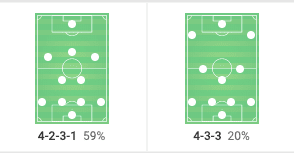
While the side is set up with a double pivot to begin with, Katie Zelem is given license to roam forward when she identifies an opportunity. On many occasions this term we have seen her leading an attack from deep in her own defensive third, as United look to use their strength on the counter-attack to their advantage.
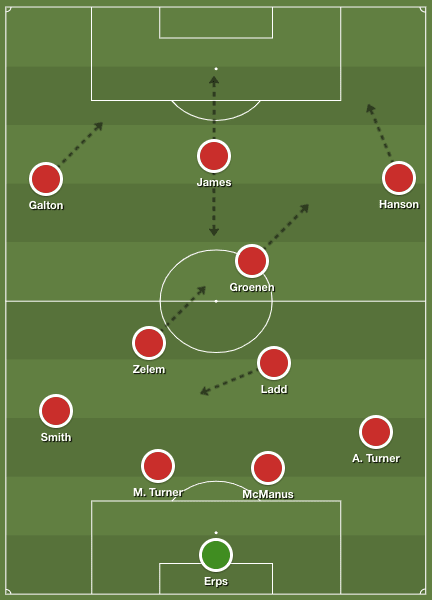
Above you can see this typical United set up. This is used when they are without possession. The arrows indicate the players’ movement as the side gain possession and look to move forward in attack. This set-up has allowed United to be defensively resolute. While struggling to create chances, none of the big three in the league were able to score more than once against Stoney’s side in their first encounters. This will be hugely promising, with the feeling that United is capable to do one better and take points off of the title challengers high.
Statistically, there is reason to believe United are improving in this area. To begin the season, a common theme we would see was Manchester United creating a higher expected goals (xG) than they were actually converting into goals. In their season opener against City, they had an xG of 0.99 in comparison to City’s 0.68 but went on to lose 1-0. In their match against Chelsea, where they lost 1-0 again, they were only able to create 0.74 xG compared to their opponent’s 1.55. However, finding that killer edge could have been the difference in getting a result out of a match like this where they did relatively well defensively, just as City did to them in the previous example.
A problem we have seen this season, however, has been their implementation of these tactics against sides more inclined to sit deep. Using the same structure, United have often found it difficult to break low blocks down. In this tactical analysis scout report of Manchester United Women, we will look at some of the key areas for improvement that could be adjusted in order to be better equipped to deal with such scenarios.
Full-backs
United have a lineup filled with growing names in the game who will get bigger and bigger with time. One player they were unable to keep a hold of is Alex Greenwood, who left over the past summer with a move to Olympique Lyonnais on offer. The absence of the English left-back has left a gap in the side that Stoney has been unsuccessful in replacing so far. Without the marauding full-back, United lack attacking edge from these deeper wide positions. This has taken a dimension away from them going forward.
You were able to see in the previous section the typical set-up United implement with the personnel at Stoney’s disposal. With the full-backs’ tendency to remain in more defensive positions, this puts an increased amount of dependency on the wingers to create chances on their own. We can see in other English sides the benefit that an attacking full-back can bring into the side. Janine Beckie’s emergence at right-back for Manchester City Women has totally revolutionised the way the side look going forward. This is a situation United can look to draw inspiration from, as Nick Cushing’s way of giving Beckie the freedom to move up the pitch has been the introduction of a double pivot to add defensive cover. With Ladd and Zelem already offering this for United, they are possibly too defensive in their set-up, especially against lesser opposition.
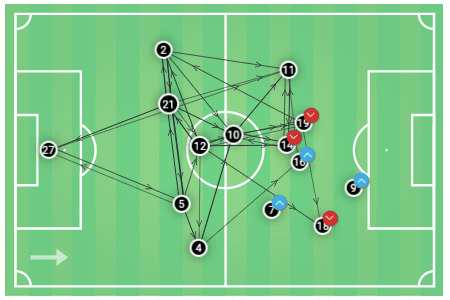
Above you are able to see United’s pass map in their 3-2 loss to West Ham United Women. This showcases the very defensive structure that is implemented. While out possessing their hosts, they were not able to fully impose themselves in this match. Katie Zelem has shown herself to be extremely effective in this role behind the main attacking quartet for United. Her positioning still allows her to provide cover in instances of possession loss, however, and the number of players in these areas should give United the option to press one of their full-backs forward.
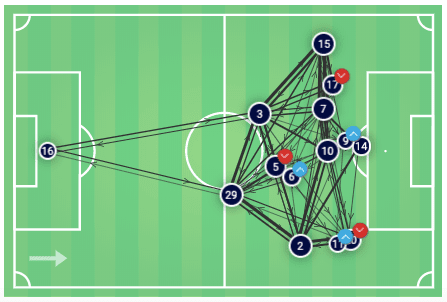
Looking back to Greenwood, we can see above a pass map from Olympique Lyonnais Women latest victory against Dijon. While the two sides cannot be compared in terms of their dominance in their domestic leagues, the attacking nature of Greenwood (15) is evident to see. The strong lines between her and her teammates showcase the attacking say she has on the match.
Right-wing
A massive area in which Manchester United Women have struggled this campaign is in scoring goals. While they are often able to create enough chances to gain a result from most matches, United consistently finish scoring below their xG in a given match. This has led to dropping points in crucial matches where, had they not, they would be sitting in a much better position in the table.
Looking at their attacking line, there is a lot of promise that will look to be fulfilled on. Lauren James is one of the games top prospects. The 18-year-old is in the midst of her first full campaign in the top flight, and while she has shown her brilliance on a consistent basis, she is still finding her rhythm in front of goal. On her left, Leah Galton has arguably produced the biggest attacking threat on a regular basis. The attacking-minded winger is a nuisance for opposition right-backs, and as we discussed earlier, would only improve with the addition of a world-class attacking left-back.
The right side is where United will find their most room for improvement. Stoney has been searching for the right fit in this area all season. Kirsty Hanson and Jessica Sigsworth have been the primary two sharing time in this area, but neither has made the position their own. Due to this, United could look to improve in this area come the summer.
A player that fits the mould of what would take Manchester United Women in the right direction is Caroline Hansen of Barcelona Femini. The Norwegian right-winger has been in fine form this campaign and excels in a lot of the areas we have discussed United’s struggles in. She averages 10.45 dribbles per game, similar to that of Hanson. However, she has a completion percentage of 67.4%, a significant increase on her counterpart. Hansen’s attacking output is also extremely impressive. While Hanson goals per game average is .46, her xG of 0.28 suggests that she has been overperforming in front of goal. Hansen’s split is much closer, averaging 0.55 goals per match with an xG of 0.49. The Barcelona winger also collects 0.55 assists per match, with a 0.5 xA. Hanson averages 0.15 assists with an xA of 0.25.
Breaking down deep blocks
A common theme the likes of Arsenal and Manchester City see in the league are opponents setting up from the start of matches to defend deep and look for one or two chances to seriously commit numbers forward to attack. As Manchester United continue to improve this is a tactic they will begin to see more often. We got an example of this at the beginning of January, where United were shut down by a resilient Bristol City side, who came away 1-0 winners on the day. This match will have frustrated Stoney with how relatively ineffective her side was at moving Bristol’s block and finding ways to work through.
As we discussed in the full-backs section, United’s set-up could be a major reason behind this inability to break down deep blocks. Using the adjustments to the two areas in the previous sections, below you can see a team shape United could adopt in matches like this one against Bristol.
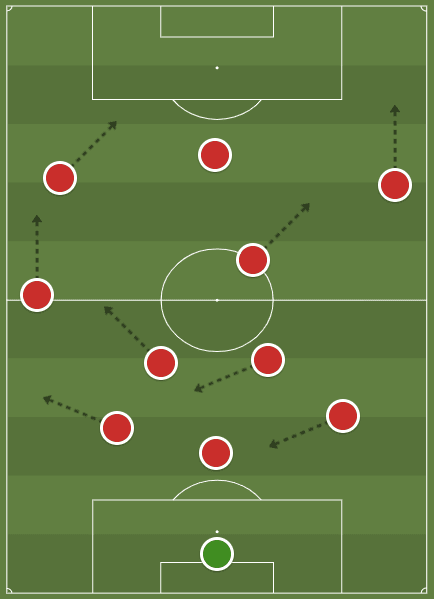
This structure provides multiple attacking advantages they lack in their usual ones. One of the adaptions Stoney would need to make with a more attacking-minded full-back is their build-up and defensive structure. With United’s personnel, they have full-backs capable of filling into these deep positions as we have seen throughout the season. Moreover, they would be able to transition into a more central position to form a back three with their central defenders due to these defensive tendencies. Ahead of them, not much would be necessary to change for the double pivot of United. Zelem would often find the need to drift into the left half-space with an attacking left-back.
This would be beneficial for the side on both sides of the ball. Going forward, Zelem’s passing range would allow her to easily move the ball in between the attacking players. With a full-back joining Galton on the left side, and James at centre-forward with her instincts to drop deep to help in possession, United could look to create overloads on this side of the pitch on a consistent basis throughout the game. Zelem would be able to sit deep and look to find passes through the lines into one of these players or switch play to the right side, which we will look at in a minute. Defensively, her positioning in a more left-sided position would allow cover for the left-back as they look to get forward. She would be on hand to prevent or slow down any quick counter-attacks due to one of United’s attacking players losing possession.
On the right side, United could look to attack in a different way. With the overloads that could be created on the left side through the volume of players getting involved, this could often leave pockets of space in other areas on the pitch as oppositions look to avoid finding themselves in numerical disadvantages. With Groenen and a right-winger like a Hansen as we discussed above, United would possess two deadly threats when given the time and space to receive a pass and dribble forward.
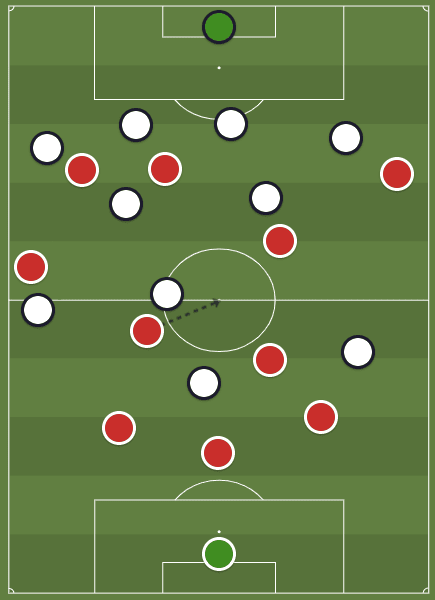
Here is an example of a scenario such as this. To combat the attacking numbers United get into the left side of the pitch, the opposition’s midfield and defenders would react by trying to make sure they held numerical advantages in this area of attack. However, as you can see, Zelem (with the arrow) has the intelligence and passing ability to acknowledge these opportunities and switch play to the opposite side. Here, the United attackers are in one-v-one situations with their markers and could look to quickly dribble forward or combine with one another to create an opportunity on goal.
Conclusion
Manchester United Women have gotten off to a very promising start to their life in the top flight of English football. However, to truly start to work their way into the conversation they will be aiming for as one of the top sides in the league, there is still work to be done. As they continue to grow in stature, they will be forced to come away from their counter-attacking style of play as teams will sit off of them and look to defend deep themselves. With this, United will be forced to change their tactics to continue to progress towards their push to the summit of the English top flight.
Stoney has shown fantastic ability to lead her side throughout recent years and she will undoubtedly be ready to continue in this vein. Fourth place in the table should be their aim as they look to finish out the campaign strong. With a trip to Arsenal and hosting both Chelsea and Manchester City at Leigh Sports Village still to come, there is plenty of opportunities to look to improve upon their first half of the season and have a say in where the title lands come season’s end.






Comments